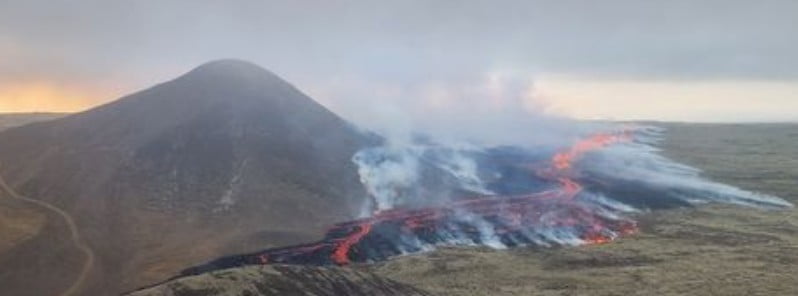Intensity of the eruption in Iceland decreased, new fissures may open rapidly

Since its onset at 16:40 UTC on Monday, July 10, 2023, the eruption near Litli-Hrútur mountain on the Reykjanes Peninsula has seen a significant drop in intensity, with fewer and smaller lava fountains now compared to the initial stages. This is likely due to a decrease in the release of magma, gases, and lava, which are now focused on fewer vents. Despite this apparent lull, the Icelandic Met Office (IMO) strongly advises against approaching the eruption site. The area poses several risks, including the potential for dangerous and even lethal gas concentrations in low-lying areas, and the sudden opening of new eruption fissures near existing vents, among other hazards.
A lava-producing fissure eruption is currently taking place near Litli-Hrútur mountain on the Reykjanes Peninsula. Fortunately, the eruption is happening in an uninhabited area, posing no immediate threat to infrastructure. Unlike many volcanic eruptions, this one is not producing volcanic ash. However, close to the eruption site, the primary hazards are the glowing, flowing lava and the emission of volcanic gases. Initial gas measurements at the eruption site indicate levels similar to those recorded during the 2022 eruption. Additionally, the flowing lava has the potential to ignite localized grass fires, which would further deteriorate air quality in the vicinity of the eruption site.
The latest data indicates that magma is moving beneath Keilir Mountain, causing changes to the landscape between Litli-Hrútur and Keilir. If new eruption vents were to form, they would most likely appear at Litli-Hrútur, IMO said.
There are now fewer and smaller lava fountains compared to when the eruption first started. The seismic activity, or ground vibrations, caused by the eruption reached its highest point between 21:00 UTC and midnight on Tuesday, July 11, and has been steadily decreasing from midnight to 11:00 UTC. This is likely due to a decrease in the release of magma, gases, and lava, which are now focused on fewer vents.
New imagery from ICEYE, covering the period from July 9 to 10, 2023, shows that the changes in the landscape caused by the magma moving between Fagradalsfjall and Keilir have extended about 1 km (0.6 miles) further northeast (compared to Saturday, July 8), reaching beneath Keilir Mountain. The images also show a narrowing of the faults around the magma channel near the eruption fissure that formed at the eastern base of Litli-Hrútur Mountain and northeast of it, between Litli-Hrútur and Keilir. This is the same location as the magma movement, as suggested by earlier models.
The lava flow is currently mostly directed to the southeast and into a shallow valley south of Litli-Hrútur. It is expected to fill this valley soon and continue flowing south. Lava may also potentially flow towards the southeast of a small ridge at the edge of the shallow valley. From there, the likely flow paths are towards the south and around the ridge. At present, the lava is not flowing westward or northward from the eruption site. If the lava continues to flow southwards, it is expected to eventually flow into and over the 2022 Merardalir lava flow.
As observed during the 2021 and 2022 magma movements, GPS measurements from further away are now showing very little change in the landscape, and seismic activity in the region has decreased significantly. Today’s earthquake activity is almost exclusively concentrated around Keilir and towards Kleifarvatn, where most of the earthquake activity triggered by last week’s magma movement was observed. However, just before the eruption, small earthquakes at very shallow depths were detected under Litli-Hrútur.
It’s important to note that conditions near the eruption fissures and lava field can change rapidly, IMO said and advised people to avoid the eruption site due to the following key hazards:
- Persistent and localized air pollution that increases when winds are low. Dangerous and potentially fatal gas levels may accumulate in low areas.
- Lava can ignite vegetation fires that can significantly decrease air quality at the site.
- New eruption fissures may open near the existing vents with little warning.
- Pieces of lava may fall from the edge of the lava flow, and new lava may suddenly advance from and over the edge at speeds that could potentially outpace a person.
Update
Access to the area has been opened from Suðurstrandarvégur on Tuesday afternoon (LT), but not from other roads.
Isak Finnbogason provided an amazing and unique live stream of the eruption on Monday, with awesome imagery and commentary. His next live stream is scheduled to start at 17:00 UTC today.
References:
1 Minor volcanic eruption on the Reykjanes Peninsula – IMO – July 11, 2023
Featured image credit: IMO



Commenting rules and guidelines
We value the thoughts and opinions of our readers and welcome healthy discussions on our website. In order to maintain a respectful and positive community, we ask that all commenters follow these rules.